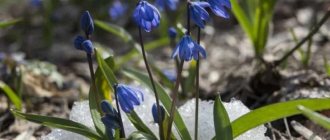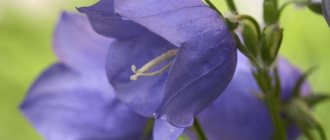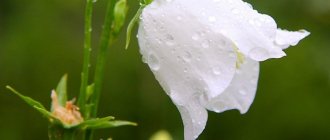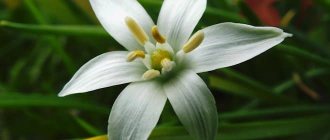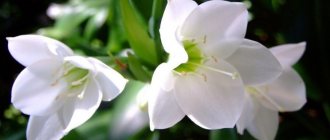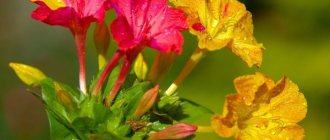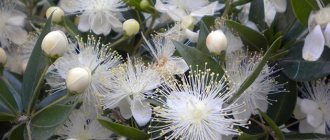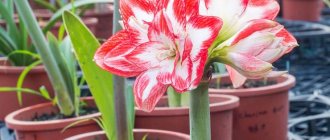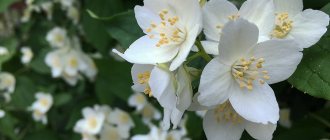Spring-blooming scillas
Scillas blooming in spring are quite unpretentious: their winter temperature minimum is around -15°C. I will give the most popular types and varieties.
Vithynian Scilla
Bithynian scilla (Scilla bithynica) is a small bulbous perennial 10-15 cm high and 8 cm wide;
originally from Bulgaria, Turkey. Bithynian scilla. Photo from hardyplantresources.org.uk There are 3-5 basal leaves (that is, at the base of the stem, in this case at the peduncle), 20 cm long, developing in the spring. The flowers are blue, star-shaped, 2 cm in diameter, collected in racemes of 6-12 pieces; bloom in spring.
Scilla Hohenacker
Hohenacker's Scilla (Scilla hohenackeri) is a bulbous perennial 10-20 cm high and 5 cm wide;
originally from Azerbaijan, Iran. Very similar to Cilician scilla (Scilla cilicica). Close-up of Hohenacker's scilla. Photo from pacificbulbsociety.org. General form. Photo from wakerobin.co.nz Linear leaves, 3-5 pieces, 10-25 cm long. Light blue flowers, 1.5 cm in diameter, collected in racemes of 4-12 pieces; bloom in spring.
Scilla bifolia
Scilla bifolia is a small bulbous perennial 8-15 cm high and 5 cm wide;
originally from Central, Southern Europe, Turkey. Scilla bifolia. Photo from summitpost.org There are 2 basal leaves, they are broad-linear, 5-20 cm long. Flowers are blue to purple-blue, star-shaped, 2.5-4 cm in diameter, often collected in one-sided racemes of up to 10 pieces; bloom in early spring.
Scilla Cilician
Cilician scilla (Scilla cilicica) is a bulbous perennial 15-35 cm high and 8 cm wide;
originally from Turkey. Cilician scilla. Photo from commons.wikimedia.org There are 3-4 basal leaves, they are broad-linear, 15-25 cm long, appear in autumn. The flowers are lavender-blue, 2-3 cm in diameter, collected in clusters of 5-15; bloom in spring. Winter minimum temperature is -10°C.
Lily-hyacinth scilla
Lily-hyacinth scilla (Scilla liliohyacinthus) is a small bulbous perennial plant 15-25 cm high and 7 cm wide;
originally from the South-West of France, Spain. Lily-hyacinth scilla close-up. Photo from luirig.altervista.org. General form. Photo from the website asturnatura.com There are 6-10 basal leaves, they are shiny, oblanceolate, 15-30 cm long. The flowers are lilac-blue, rarely white, 1.5 cm in diameter, collected in racemes of 5-20 pieces; bloom in late spring.
Siberian Scilla
Siberian blueberry (Scilla siberica) is the most common bulbous perennial, 10-20 cm high and 5 cm wide;
originally from Russia, Ukraine, Georgia, Azerbaijan, Northern Iran. Siberian Scilla There are 2-4 basal leaves, they are broad-linear, 10-15 cm long. The flowers are cup-shaped, drooping, bright blue, 1.5 cm in diameter, collected in groups of 4-5; bloom in spring. Peduncles gradually lengthen.
Decorative varieties
- 'Alba' – white flowers;
Siberian bluegrass variety 'Alba'. Photo from flickr.com
- 'Spring Beauty' – up to 20 cm high, dark blue flowers.
Siberian bluegrass variety 'Spring Beauty'.
Photo from the site panoramio.com Some scillas on sale may be presented under the guise of other plants.
Late-blooming and less common scillas
They are also winter-hardy: their winter temperature minimum is -15°C.
Spanish Scilla
You can find Spanish blueberry (Scilla hispanica) in trade catalogs under the name Spanish hyacinthoides .
She comes from Portugal, Spain, and North Africa. Spanish scilla. Photo from panoramio.com This is a strong bulbous perennial 40 cm high and 10 cm wide; grows quickly. The leaves are belt-shaped, shiny, dark green, 20-60 cm long. The flowers are bell-shaped, blue, 2 cm in diameter, collected in racemes up to 15; bloom in spring. Decorative varieties
- 'Excelsior' – 50-55 cm high, flowers violet-blue, with light blue stripes;
Spanish bluegrass variety 'Excelsior'. Photo from fluwel.com
- 'La Grandesse' – white flowers, 2.5 cm in diameter;
- 'Rosabella' – violet-pink flowers, in racemes.
Spanish bluegrass variety 'La Grandesse'.
Photo from us.floralimage.com. Spanish bluegrass variety 'Rosabella'. Photo from paghat.com Interesting? Healthy? Then we continue our review.
Scilla Peruvian
Peruvian scilla (Scilla peruviana) is an almost evergreen bulbous perennial 15-30 cm high and 10 cm wide. It comes from Portugal, Spain, Italy, and North Africa.
Peruvian scilla. Photo from gardendesign.com Leaves: from 5 to 15 pieces, lanceolate, 40-60 cm long, young ones develop in autumn to replace old ones. The flowers are dark purple, blue, white, 1.5 cm in diameter, collected in conical racemes of 50-100 pieces; bloom in summer.
- Decorative form: f. alba – flowers are white, collected in capitate inflorescences.
Scilla Peruvian form alba. Photo from deeproot.co.uk. Drawing with her image. Photo from the site nature.jardin.free.fr And now – a scilla for lovers of dwarf plants.
Proleska Mishchenko
Mishchenko's Scilla (Scilla mischtschenkoana) is a dwarf bulbous perennial 10-15 cm high and 5 cm wide. It comes from Georgia, Armenia, Azerbaijan, and Iran.
Scilla Mishchenko. Photo from rhs.org.uk There are 3-5 linear basal leaves, 4-10 cm long. The flowers are blue, with darker stripes, 2 cm in diameter, collected in racemes of 2 or 6; bloom in spring.
Description of the flower
Inexperienced gardeners focus on plants that are minimally demanding and adapt well to various conditions. They are much more practical than exotic varieties of crops that require complex care. A good choice is scylla, also known as scilla, sometimes classified as one of the snowdrops. This type is quite decorative and has an excellent immune level. Scylla is a typical perennial.
In nature, it is found in various regions of Europe, Asia and even Africa. Traditionally, this genus was classified as part of the Liliaceae or Hyacinthaceae family, but then botanists changed their point of view.
According to modern classification, it belongs to the Asparagus family, other representatives of which are:
- aloe;
- purchased;
- Pushkinia;
- lily of the valley;
- hyacinth;
- yucca;
- actually asparagus.
Primrose - another name - is quite frost-resistant. The culture looks quite beautiful. These are typical spring perennials. Outwardly they look gentle and elegant. In nature, Scylla inhabits forest and meadow areas, where it forms a lush blue carpet. Scilla is very stable and tenacious. It is characterized by elongated internodes. As they develop, the stems turn into thin rhizomes. The bulbs are distributed along their sides. Flowering in indoor and garden specimens is characteristic of only a few varieties.
Exotic scilla
To be precise, this scilla is suitable for growing on the southern coast of Crimea and the Black Sea coast of the Krasnodar Territory, since its minimum temperature is 0°C.
Scilla Natal
Natal Scilla (Scilla natalensis) is a bulbous perennial 30-120 cm high and 8 cm wide, native to South Africa.
Natal Scilla flowers close-up. Photo from maliba-lodge.com. General view of the Natal scilla. Photo from plantzafrica.com There are 4-8 leaves, they are linear, up to 20 cm long (during flowering), later - up to 30-60 cm. The flowers are violet-blue, blue, pink, 1.5 cm in diameter, collected in inflorescences -brushes up to 100; bloom in summer.
Planting in open ground
As a rule, scylla is not planted individually: the plants are collected in flower beds or distributed around trees.
Time
Experienced gardeners recommend replanting spring scylla in open ground in mid-June, and autumn scylla - towards the end of August.
Place
You can plant flowers on both the sunny and shady sides. It all depends on the variety and flowering time: spring species prefer warmth and sun, while autumn species feel better in the shade and coolness.
During rainy or cool days, Scylla leaves are arranged horizontally and almost lie on the ground, while in sunny weather they stand vertically.
Scillas love
- semi-shaded places (in open areas in the first years of planting they are mulched with peat, humus, dry leaves; but immediately after the snow melts, the cover is removed);
- soils: loose, drained, fertile, moist, non-acidic (if you are not sure that you know exactly what kind of soil you have on your site, take a look at the article How to find out the type of soil and why this is needed);
- they grow in one place for years, but to preserve decorativeness, transplantation is carried out after 3-4 years;
- fertilizing with complex mineral fertilizer in the snow (or immediately after melting) and during flowering;
- loosening the soil;
- watering during dry periods.
You can find a large assortment of various complex fertilizers in our catalog, which combines the offers of many large garden online stores. View a selection of mineral complex fertilizers. Complex organic fertilizer Organic Mix Universal, 200 g 165 rubles
seedspost.ru
Living Fertilizer Biocomplex-BTU ® Universal, 15 ml 32 rub.
seedspost.ru
Kimira Universal (2.5 kg.) 432 rub.
Agrofirm Search
Spring Kimira (1 kg.) 170 rub.
Agrofirm Search
Care
Scilla does not require special care. Watering is carried out only in very dry weather with a long absence of rain. It is necessary to water the scylla at the very base. When water gets on the leaves and flowers, the plant loses its shape.
Fertilize Scylla during the period of active flowering once with mineral complexes. This promotes long and abundant flowering. Before applying fertilizer, the soil around the plant must be well loosened.
To avoid overgrowing with weeds, scylla can be mulched with straw or humus.
Placement of woodlands in the country
They are magnificent under trees and shrubs, in mixborders, rockeries, and low garden vases.
Siberian Scilla with Erica grass Spring-blooming Scilla look harmonious with Galanthus, Erica, and crocuses that bloom at the same time. It is necessary to plant peonies, bergenia, hosts, ferns and other perennials nearby, which can cover them after flowering.
Reproduction
To reproduce, you will need Scylla seeds or babies. In addition to the method described above, you can propagate the plant using seeds, which must first be prepared.
You need to collect seed boxes towards the end of June, when they become yellow and crack. The seeds are taken out of them and immediately planted in the designated place. But since the seeds are difficult to germinate, this method is not the fastest for growing. You will have to see the first flowers no earlier than after 3 years.
